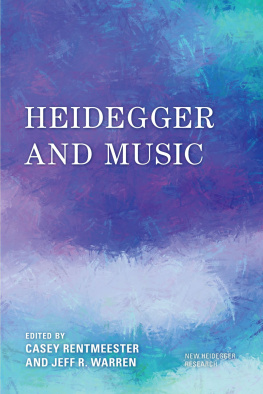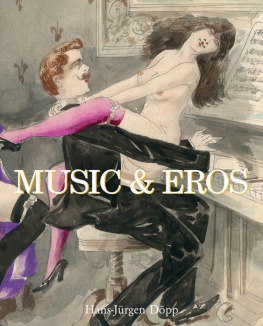Contents
List of Figures
Guide
Pagebreaks of the print version

SEX SOUNDS
Vectors of Difference in Electronic Music
DANIELLE SHLOMIT SOFER
The MIT Press
Cambridge, Massachusetts
London, England
2022 Massachusetts Institute of Technology
This work is subject to a Creative Commons CC-BY-NC-ND license.
Subject to such license, all rights are reserved.

The MIT Press would like to thank the anonymous peer reviewers who provided comments on drafts of this book. The generous work of academic experts is essential for establishing the authority and quality of our publications. We acknowledge with gratitude the contributions of these otherwise uncredited readers.
Portions of chapter 7 were previously published in Danielle Sofer, Breaking Silence, Breaching Censorship: Ongoing Interculturality in Alice Shieldss Electronic Opera Apocalypse, American Music 36, no. 2 (2018): 135162.
Portions of Chapter 9 were previously published in Danielle Sofer, The Macropolitics of Microsound: Gender and Sexual Identities in Barry Truaxs Song of Songs, Organised Sound 23, no. 1 (April 2018): 8090.
Library of Congress Cataloging-in-Publication Data
Names: Sofer, Danielle, author.
Title: Sex sounds : vectors of difference in electronic music / Danielle Shlomit Sofer.
Description: Cambridge, Massachusetts : MIT Press, 2022. | Includes bibliographical references and index.
Identifiers: LCCN 2021033957 | ISBN 9780262045193 (paperback)
Subjects: LCSH: Electronic musicHistory and criticism. | Sex in music.
Classification: LCC ML1092 .S64 2022 | DDC 786.7dc23
LC record available at https://lccn.loc.gov/2021033957
d_r0
Contents
List of Figures
) A time-domain representation ofFish & Fowlplotting amplitude over time. (Bottom) A map of audible breath (instrumental and human combined). The opacity of the shading indicates intensity by a change in volume and higher periodicity.
Recurring themes inFish & Fowl. Numbers indicate time in minutes.
Excerpt from Hodkinsonssagte er, dachte ich, mm. 18.
Excerpt of Torso fromTriumphby Niels Rnsholdt, womans voice inhale/exhale with whip (slap stick), mm. 17.
Letter fromFish & FowlCD booklet.
Excerpt of Torso fromTriumphby Niels Rnsholdt, clarinet and womans breathing with whip (slap stick), mm. 3035.
Excerpt of Torso fromTriumphby Niels Rnsholdt, ensemble, mm. 108114.
Ahhh Love to Love You, Baby hook.
Melody of verses in Summers Love to Love You Baby outlines a descending chromatic tetrachord every half bar, ending in a turnaround bar looping back to the hook (figure 6.1).
Chromatic descending tetrachord, sustained ambient string background from Love to Love You Baby (11:4012:40).
Parallel chromatic descending tetrachords, backup singer chorus (in black) and sustained ambient string background (in gray) from Love to Love You Baby (11:4012:40). E-flat and G sustained throughout.
Shiva as Lord of Dance (Nataraja), Chola period (8801279), ca. eleventh century. New York, Metropolitan Museum of Art. Copper alloy, height 26 7/8 in. (68.3 cm); diameter 22 1/4 in. (56.5 cm). Gift of R. H. Ellsworth Ltd., in honor of Susan Dillon, 1987. Acc.n.: 1987.80.1. Photo: Bruce White. 2017. Image copyright The Metropolitan Museum of Art / Art Resource / Scala, Florence.
Loving couple (Mithuna), Eastern Ganga dynasty, thirteenth century. New York, Metropolitan Museum of Art. Ferruginous stone, height 72 in. (182.9 cm). Purchase, Florance Waterbury Bequest, 1970. Acc.n.: 1970.44. Photo: Bruce White. 2017. Image copyright The Metropolitan Museum of Art / Art Resource / Scala, Florence.
Hand gestures illustrated by Alice Shields in theApocalypselibretto, page 82.
Postures illustrated by Alice Shields in theApocalypselibretto, page 81.
Apocalypse Song, A section, composers transcription.
Apocalypse Song, B section, composers transcription.
Fundamental frequency and gender perception.38
Song of Songs, i: Morning, line 5. Transformation of perceived gender identity and sexual orientation in fair and (t)errible voices. Oboe damore in A.
Song of Songs, ii: Afternoon, lines 35. This transcription shows the strongest sounding fundamentals in the bass clef, the time-stretched fountain sounding in the ambiguous register, in a range around E-flat, or 155.5Hz. X noteheads on lines 3 and 5 indicate the aliasing caused by the consonants t and n. Oboe damore notated at concert pitch.
Song of Songs, iv: Night and Daybreak, lines 79. Ambiguously gendered voices, as if spoken through a vocoder, notated in the bass clef. English horn in F.
Harmonic reduction of acoustic guitar accompaniment to verses in TLCs Im Good at Being Bad, featuring descending chromatic tetrachord.
Alternating descending and ascending minor triad arpeggiation, sustained ambient synthesized background from Im Good at Being Bad (2:563:17).
Ascending hexachord B-flatG (Motive 1) with leap followed by gap fill (Motive 2), opening Verse 1, Janelle Mones Its Code (0:120:17).
Ascending hexachord (Motive 1) with leap followed by gap fill (Motive 2) and wobble, continued Verse 1, Janelle Mones Its Code (0:591:04).
Ascending scale suggesting a variation of Motive 1, with leap followed by gap fill lead up to a wobble that never arrives, pre-chorus, Janelle Mones Its Code (1:111:15).
End of chorus through arrival on You preparing for Motive 1 but evaded by instrumental interlude, Janelle Mones Its Code (1:391:46).
Janelle Mone and Esperanza Spalding, Dorothy Dandridge Eyes, opening vocal line (0:200:37).
Descending hexachord loop throughout Stas THEE Bosss song Before Anyone Else,SWomen(2017).
Parallel thirds punctuated by a wobble on the words sad queers in Stas THEE Bosss song Before Anyone Else (1:061:08),SWomen(2017).
List of Tables
Structure of the Erotica movement fromSymphonie pour un homme seul
Simplified formal scheme of Sprinkle/BeattysSluts & GoddessesVideo Workshop
Songs featuring a wobble warp
Works by Niels Rnsholdt
Works by Juliana Hodkinson
Acknowledgments
Thank you to all the haters.
I want to thank all those institutions and individuals that have so firmly enforced boundaries. The musical, social, categorical, political, geographical borders, the static and staid canons up against which I have been continually thrust through the writing process and ever since growing up in this world as a Jewish, mixed-race, nonbinary person. Colonizers, white supremacists, Lacanians, proponents of Great work of Great men, science-allied music theorists, pinkwashing homonormative gays, the TERFiest separatist feminists have all had a hand in this book. This book would have been much worse without their persistent bigotry, intolerance, and indifference. The injustices of this world came to new heights while I was writing this book. I watched in horror at the quick dissolution of Jeffrey Epsteins trial. I toiled over his influence on MIT, the very institution whose name underwrites the contents of this book, and whose press, at that time, had already generously contracted my book. Denying the words of this book to the world would not have been useful to those who suffered intentional harm or by way of indifference at such violently upheld boundaries. Instead, I vow to reallocate financial proceeds accrued personally from this publication by donating a portion of the accumulated royalties to resources supporting trans youth of color.













